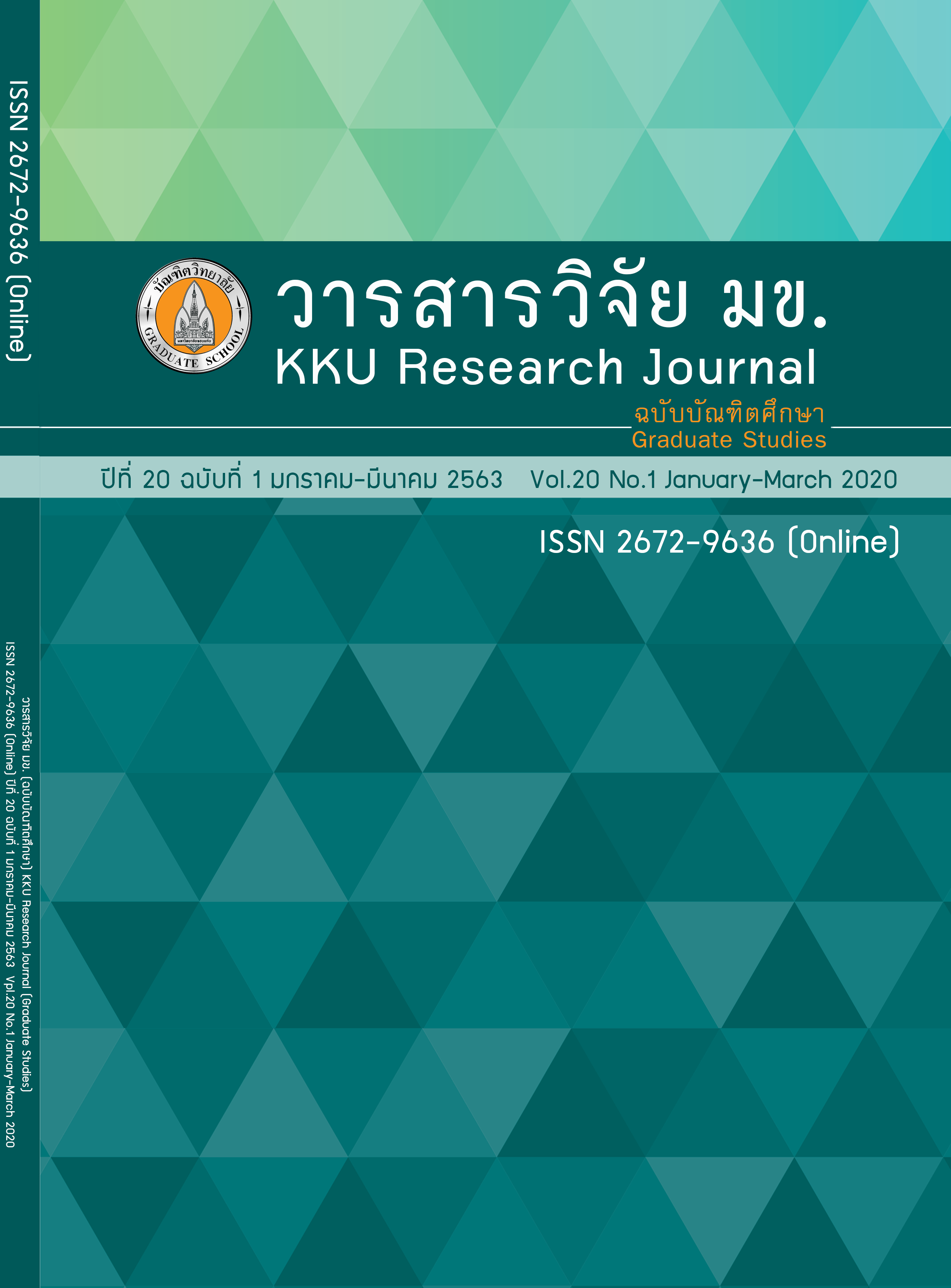การวิเคราะห์สาเหตุการวิบัติของเชิงลาดสะพานและแนวทางการปรับปรุงแก้ไข: กรณีศึกษา ทางหลวงหมายเลข 2133 ตอน ศรีบุญเรือง – ภูเวียง ที่ กม.31+087
คำสำคัญ:
การวิบัติของเชิงลาดสะพาน, การกัดเซาะ, ค่าอัตราส่วนความปลอดภัยบทคัดย่อ
สะพานเป็นสิ่งก่อสร้างที่ใช้สำหรับข้ามลำน้ำ หรือข้ามสิ่งกีดขวาง เพื่อประโยชน์ในการสัญจร และยังทำหน้าที่ในการระบายน้ำอีกด้วย เมื่อสะพานเกิดการชำรุด ทำให้เกิดความไม่ปลอดภัยกับผู้ใช้เส้นทาง การชำรุดของสะพานมีหลายรูปแบบ สาเหตุหลักของการชำรุด เกิดจากน้ำท่วมและการกัดเซาะรอบโครงสร้างสะพานส่วนล่าง ทั้งนี้ปัญหาได้ทวีความรุนแรงมากขึ้น เนื่องจากสภาวะภูมิอากาศที่เปลี่ยนแปลงไป ทำให้แต่ละปีมีแนวโน้มในการเกิดอุทกภัยมากขึ้น ผนวกกับอายุการใช้งานของสะพานที่มากขึ้น จะส่งผลให้มีความเสี่ยงต่อการวิบัติของเชิงลาดสะพาน งานวิจัยนี้นำเสนอผลการศึกษาการวิเคราะห์เสถียรภาพของเชิงลาดสะพาน ในสภาวะความชื้นและระดับความลึกของการกัดเซาะที่แตกต่างกัน เพื่อหาค่าอัตราส่วนความปลอดภัย (Factor of Safety) ซึ่งผลจากการวิเคราะห์เสถียรภาพแสดงให้เห็นถึงสาเหตุของการวิบัติของเชิงลาดสะพาน โดยการวิบัติจะเกิดขึ้นในช่วงที่ดินมีสภาวะความชื้นสูงและระดับการกัดเซาะลึกมากกว่า 1.20 เมตร โดยประมาณ
References
Mairiang W. Earth fills Dam Engineering, Bangkok: Library Nine. 1999.
Korkitsuntornsan W. Seismic Hazard Analysis of Thailand. Master’s thesis, Department of Civil Engineering, Faculty of Engineering, Chulalongkorn University. 2016.
Mary E, Hynes-Griffin,Arley G. Franklin. Geotechnical Laboratory, Department of the Army Waterways Experiment Station, Corps of Engineers. PO Box 631, Vicksburg, Mississippi, USA. 1984.
NAVFAC Design Manual 7.10 Soil Mechanic, Department of the Naval Facilities Engineering Command, Chapter 7, Slope Stability and Protection. 1986.
AASHTO. Standard Specifications for Highway Bridge. Washington DC, USA. 2002.
Department of Highways. Standard Drawing for Highways Design and Construction (revision 2015), Ministry of transport, Thailand. 2018.
Department of Highways. Guide to correcting and operating the erosion and slope movement, Bureau of Road Research and Development, Department of Highways, ministry of transport, Thailand. 2008.
Abramson LW, Lee TS, Sharma S, Boyce GM. Slope Stability Stabilization methods, John Wiley and Sons, Inc., New York. 1996.
Angsuwotai P.Foundation Engineering, Department of Civil Engineering, Faculty of Engineering, Khon Kean University. 1982.
Horpibulsuk S. Foundation Engineering. Institute of Engineering Suranaree University of Technology. 2012.
Likitlersuang S. Soil Mechanics: Fundamentals, Bangkok: Chulalongkorn University Press. 2014.
Meyerhof GG. Safety Factor in Soil Mechanics, Canadian Geotechnical Journal, Vol.7(4): 349-355. 1970.
Muktabhant C. Soil mechanics, Department of Civil Engineering, Faculty of Engineering, Khon Kean University. 2001.
Price T. Warwick University. URL:http//fbe.vwc.uk/pubric/geocal/Slope/Slopes.html. 2006.
Tanseng P. Foundation Engineering, Institute of Engineering Suranaree University of Technology. 2011.
Terzaghi K, Peck RB, Mesri G. Soil Mechanics in Engineering Practice, John Wiley and Sons, Inc., New York. 1996.
Varnes DJ. Slope movement types and processes, Transportation Special Report No. 176, National Academy of Sciences, Washington DC. 1978.


